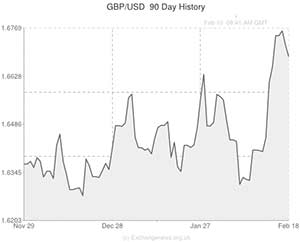
The Pound to US Dollar exchange rate (GBP/USD) could reassert itself above technical resistance at 1.6745 today if this morning’s UK Unemployment print shows further signs of improvement in the British labour market.
Sterling slipped below 1.6700 during yesterday’s session as markets reacted to a below-forecast UK CPI inflation reading of 1.9%. Post-Christmas high street sales and cheaper recreational services prices helped drive the Consumer Price Index down to its lowest level since November 2009 – the last time that inflation fell below the Bank of England’s 2.0% target.
US data also disappointed, but a -10 point fall in the NAHB Housing, index from 56 to 46, had a muted impact on GBP/USD trading.
Later this morning the International Labour Organisation (ILO) will announce Britain’s Unemployment Rate for the three months leading up to December. Economists predict that the jobless rate will print at 7.1%, however, with 250,000 new jobs estimated to have been created during that time it is feasible to suggest that the Unemployment Rate could actually have fallen to 7.0%.
Now a drop to 7.0% will not necessarily be heralded as the profound event that it would have been at the start of last week’s session. This is because the Bank of England decided to scrap its 7.0% Unemployment threshold for considering hiking interest rates during Governor Mark Carney’s Quarterly Inflation report last Wednesday. The Bank instead opted to start measuring a broader range of economic indicators.
However, another surprisingly optimistic labour market figure is still likely to have a significant impact on Sterling trading, and it is entirely possible that a result of this nature could send the Pound to US Dollar exchange rate (GBP/USD) back above technical resistance at 1.6745.
The Bank of England is also set to release the Minutes from its latest meeting, however, the report should not prove too troubling to holders of the Pound because it is not likely to feature anything groundbreaking; the Quarterly Inflation report, which took place after the BoE meeting, has already outlined the Bank’s new vision for monetary policy.
During the evening the Federal Reserve will also release its latest Minutes report. The meeting in question, held between January 28-29, saw the US Central Bank cutback on stimulus despite the recent spate of soft economic data Stateside. The latest -$10 billion taper suggests that policymakers see the polar vortex as the main cause of the recent slowdown, suggesting that asset purchases will continue to be slashed at each future meeting. In the long run this mindset is liable to lead to a stronger US Dollar.
However, if the more dovish-leaning policymakers are seen to have expressed any concerns regarding the downturn in economic activity it is quite possible that the ‘Greenback’ will come under some selling pressure.

Comments are closed.